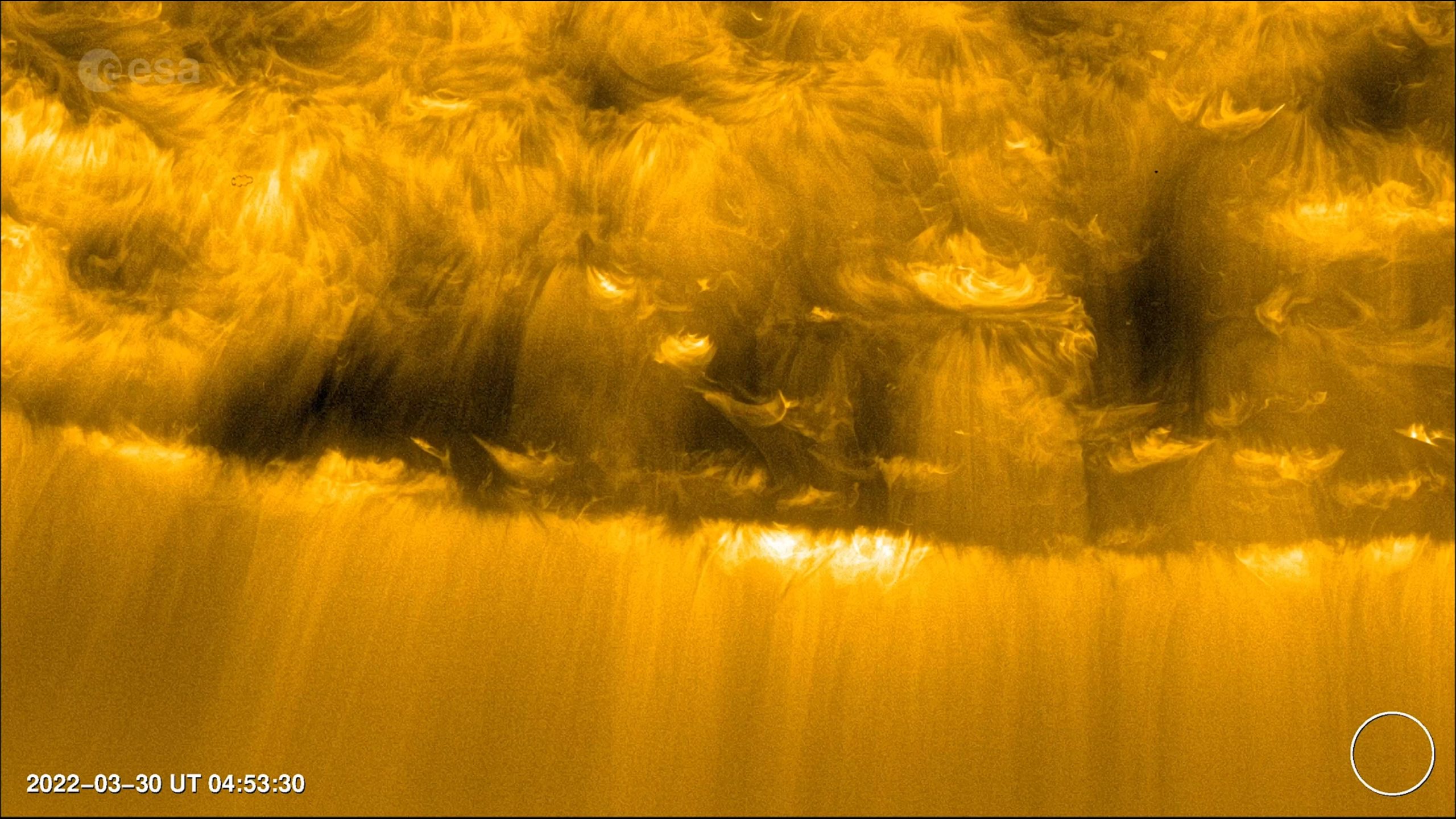The solar probe detected small jets from the Sun, which could explain the origin of the solar wind. This challenges traditional beliefs about wind generation, as the new data indicates an intermittent outflow. The findings could also have implications for understanding the atmospheres of other stars. Image credit: ESA/NASA/Solar Orbiter/EUI Team; Acknowledgments: Lakshmi Pradeep Cheetah, Max Planck Institute for Solar System Research
European Space Agency/NASA The Solar Orbiter spacecraft has detected a large number of small jets of material escaping from the sun’s outer atmosphere. Each jet lasts between 20 and 100 seconds, and goes off plasma at about 100 km/s (60 mph) or 360,000 km/h (220,000 mph). These jets could be the long-awaited source of the solar wind.
Understanding the solar wind
The solar wind is made up of charged particles known as plasma, which are constantly escaping from the sun. It spreads outward through interplanetary space, crashing into anything in its path. When the solar wind collides with Earth’s magnetic field, it produces the aurora borealis.
Although the solar wind is a fundamental feature of the sun, understanding how and where it is generated near the sun has proven elusive and has been a major focus of study for decades. Now, with its superior instrumentation, Solar Orbiter has taken us an important step forward.

This mosaic of images shows a multitude of tiny jets of material escaping from the sun’s outer atmosphere. The images come from the ESA/NASA Solar Orbiter spacecraft. They appear as dark streaks across the Sun’s surface in this mosaic. The images are “negatives” which means that although the jets are shown as dark, they are bright flashes on the Sun’s surface. Image credit: ESA/NASA/Solar Orbiter/EUI Team; Acknowledgments: Lakshmi Pradeep Cheetah, Max Planck Institute for Solar System Research, CC BY-SA 3.0 IGO
High-resolution imaging of the sun’s surface
The data comes from Solar Orbiter’s Extreme Ultraviolet Imager Instrument (EUI). Images of the sun’s south pole, taken by EUI on March 30, 2022, reveal a set of faint, short-lived features associated with small jets of plasma being expelled from the sun’s atmosphere.
“We were only able to detect these tiny jets because of the unprecedented high-resolution, high-frequency images produced by EUI,” says Lakshmi Pradeep Chitta, Max Planck Institute for Solar System Research, Germany, and lead author of the paper describing this work. . In particular, the images were taken in the extreme ultraviolet channel of EUI’s high-resolution imager, which observes solar plasma at a millionth magnitude at a wavelength of 17.4 nanometers.
Of particular interest is the fact that the analysis shows that these features are caused by the ejection of plasma from the solar atmosphere.
This movie was created based on observations taken by the ESA/NASA Solar Orbiter spacecraft on March 30, 2022, between 04:30 and 04:55. UTCIt was previously released last year. Shows a coronal hole near the sun’s south pole. Subsequent analysis revealed that many small aircraft were launched during the observation. They appear as small flashes of light shining across the image. Each of them ejects charged particles, known as plasmas, into space. The circle indicates the size of the Earth relative to scale. Image credit: ESA/NASA/Solar Orbiter/EUI Team; Acknowledgments: Lakshmi Pradeep Cheetah, Max Planck Institute for Solar System Research
Magnetic structures and the solar wind
Researchers have known for decades that much of the solar wind is associated with magnetic structures called coronal holes, regions where the sun’s magnetic field does not return to the sun. Instead, the magnetic field extends deep into the solar system.
Plasma can flow along “open” magnetic field lines, heading into the solar system, creating the solar wind. But the question was: How was the plasma fired?
The traditional assumption was that because the corona is hot, it will naturally expand and some of it will escape along the field lines. But these new findings look at a coronal hole that was located at the sun’s south pole, and the individual jets detected challenge the assumption that the solar wind is produced only in a continuous, steady flow.
“One finding here is that this flow is not very uniform, and the ubiquitousness of the jets suggests that the solar wind from coronal holes may originate as a very sporadic flow,” says Andre Zhukov, Royal Observatory of Belgium. , a collaborator on the work who led the Solar Orbiter monitoring campaign.

The European Space Agency’s Solar Orbiter mission will encounter the sun from within Mercury’s orbit at its closest point. Source: ESA/ATG medialab
Aircraft energy analysis
The energy associated with each individual plane is small. At the upper end of the coronal phenomena are Class X solar flares, and at the lower end are what are called nanoflares. There is a billion times more energy in the X flare than in the nanoflare. The tiny jets detected by Solar Orbiter are less energetic than this, exuding about a thousand times less energy than a nanoflare, and directing most of that energy into ejecting plasma.
Their ubiquity, which the new observations indicate, indicates that they expel a large portion of the matter we see in the solar wind. It is possible that there will be smaller, more frequent events that do more.
“I think it’s an important step to finding something on the disk that is definitely contributing to the solar wind,” says David Bergmans, Royal Observatory of Belgium and EUI principal investigator.
Future observations and broader implications
Currently, the Solar Orbiter is still orbiting the Sun near the equator. So, in these observations, the EUI is looking across the South Pole at a grazing angle.
“It’s hard to measure some of the properties of these little jets when viewed from the edge, but in a few years, we’ll see them from a different perspective than any other telescopes or observatories, so that should help us both a lot,” he says. Daniel Müller, ESA project scientist for the Solar Orbiter.
This is because as the mission goes on, so will the spacecraft Its orbit is gradually tilted towards the polar regions. Meanwhile, activity on the Sun will progress through the solar cycle and coronal holes will begin to appear at different latitudes, providing a unique new perspective.
All participants will be excited to see what new insights they can gather as this work extends far beyond our solar system.
The Sun is the only star whose atmosphere we can observe in such detail, but it’s likely that the same process is happening with other stars as well. This turns these observations into the discovery of a fundamental astrophysical process.
Reference: “Picoflare Jets Powering the Solar Wind Emerging from a Coronal Hole on the Sun” by LP Chitta, AN Zhukov, D. Berghmans, H. Peter, S. Parenti, S. Mandal, R. Aznar Cuadrado, U. Schühle, L. Triaka, F. Osher, K. Barzynski, E. Buchlin, L. Harra, E. Kraaikamp, DM Long, L. Rodriguez, C. Schwanitz, PJ Smith, C. Verbeeck and D.B. Seaton, Aug. 24, 2023, Available here. Sciences.
doi: 10.1126/science.ade5801
Solar Orbiter is a space mission of international cooperation between the European Space Agency and NASA, and is operated by the European Space Agency.

“Extreme travel lover. Bacon fanatic. Troublemaker. Introvert. Passionate music fanatic.”








More Stories
A fossilized creature may explain a puzzling drawing on a rock wall.
MrBeast Sued Over ‘Unsafe Environment’ on Upcoming Amazon Reality Show | US TV
Watch comets Lemmon and SWAN approach Earth today